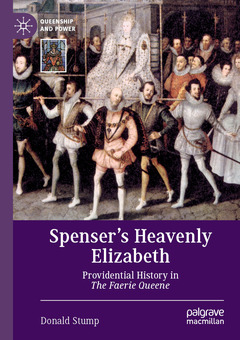Description
Spenser’s Heavenly Elizabeth, 1st ed. 2019
Providential History in The Faerie Queene
Queenship and Power Series
Author: Stump Donald
Language: English
Subjects for Spenser’s Heavenly Elizabeth:
Keywords
Edmund Spenser; The Faerie Queen; Queen Elizabeth I of England; Elizabeth I; Karl Marx; Gloriana; allegorical representations of Elizabeth; New Heaven; Book of Revelation; English Protestants; John Bale; John Fox; Henry Bullinger; Millenarian movement; Spenser's apocalypticism; Patristic tradition; Elizabethan history; Sir Phillip Sydney
Spenser's Heavenly Elizabeth
Publication date: 11-2020
Support: Print on demand
Publication date: 11-2020
Support: Print on demand
Spenser's Heavenly Elizabeth
Publication date: 11-2019
Support: Print on demand
Publication date: 11-2019
Support: Print on demand
Description
/li>Contents
/li>Biography
/li>Comment
/li>
This book reveals the queen behind Edmund Spenser?s The Faerie Queene. Placing Spenser?s epic poem in the context of the tumultuous sixteenth century, Donald Stump offers a groundbreaking reading of the poem as an allegory of Elizabeth I?s life. By narrating the loves and wars of an Arthurian realm that mirrors Elizabethan England, Spenser explores the crises that shaped Elizabeth?s reign: her break with the pope to create a reformed English Church, her standoff with Mary, Queen of Scots, offensives against Irish rebels and Spanish troops, confrontations with assassins and foreign invaders, and the apocalyptic expectations of the English people in a time of national transformation. Brilliantly reconciling moral and historicist readings, this volume offers a major new interpretation of The Faerie Queene.
I. Spenser's Method and Artistry.- 1. Introduction to Spenser's Art of Royal Encomium.- 2. Spenser, Elizabeth, and the Problem of Flattery.- 3. Gloriana, Biblical Typology, and Moral Transfiguration.- II. Spenser's Elizabeth.- 4. Una and the English Reformation.- 5. The Maturation of the Queen.- 6. The Queen in Her Glory.- III. The Faerie Queene in Context.- 7. Una, Mercilla, and the Elizabethan Apocalypse.- 8. Sidney, Spenser, and the Queen.
Donald Stump is Professor of English at Saint Louis University, USA. His publications include Elizabeth I and Her Age and Elizabeth I and the ‘Sovereign Arts,’ along with numerous articles on Renaissance literature and the Spenser and Sidney World Bibliographies. With Carole Levin, he founded the Queen Elizabeth I Society.
Offers a major new interpretation of Edmund Spenser’s The Faerie Queene Presents the necessary sixteenth-century context to understand The Faerie Queene as historical allegory Argues that Spenser’s storytelling teaches nobility through fairy history, as the Bible teaches godliness through Hebrew history Compares Edmund Spenser with Sir Philip Sidney, exploring their disagreements over the queen and her place in the providential order of history
© 2024 LAVOISIER S.A.S.




